High CPMs on Google Ads—How Do They Occur? Through hypertargeting and valuable target groups
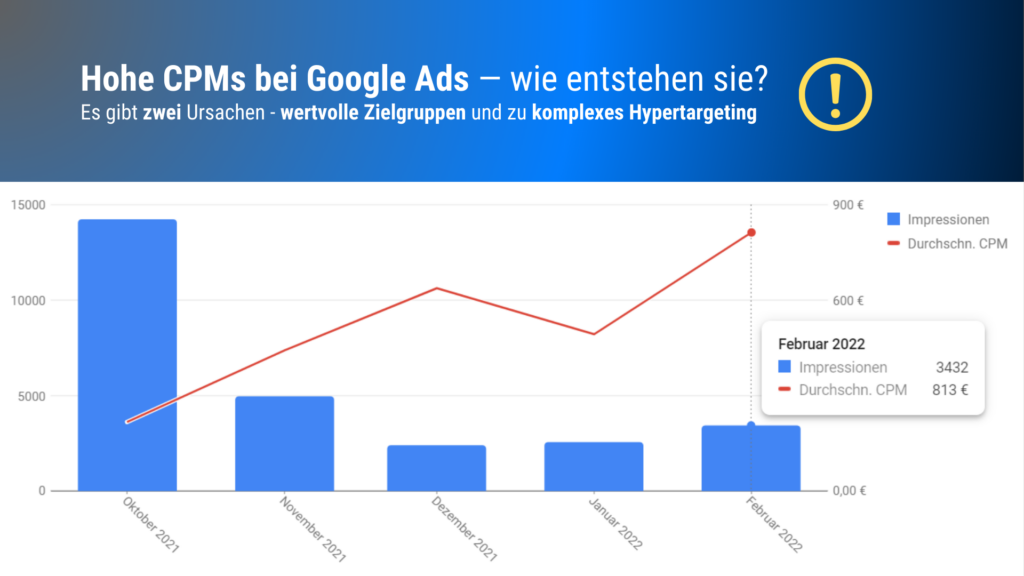
There is a widespread myth: A high CPM for Google Ads, Facebook Ads or LinkedIn Ads can only be achieved through valuable, i.e. heavily courted, target groups. In fact, there’s an even more common cause: overly complex hypertargeting.
A high CPM means a high-quality target group – so the myth goes. Accordingly, a high CPM (cost per 1,000 impressions) is basically an indicator for high-quality or even affluent target groups. That’s only partially true: there is a second, even more powerful cost driver for a high CPM – hypertargeting , whose nested conditions are expensively billed by the advertising platforms. It is important to understand how advertising platforms measure CPM.
In the Google Ads search network, the CPM is primarily measured by the booked keyword set and the value it has on an auction basis in terms of click price bids . Ad efficiency and landing page quality also play a part. The two most important factors that also drive up the CPM are: targeting complexity and competition on your audience (booked-in audience option with targeting or observation on Google Ads) We will address both points below.
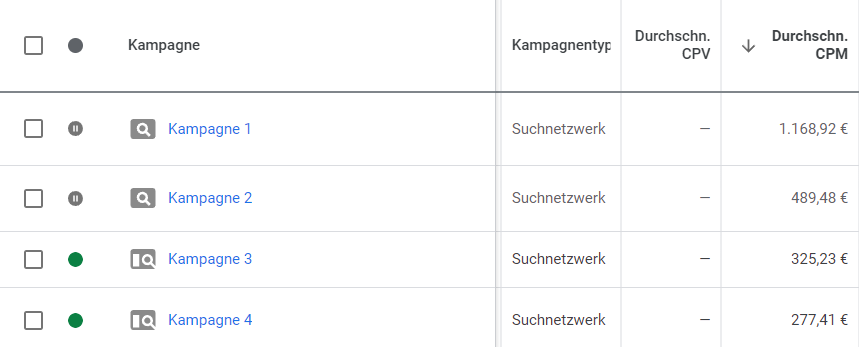
Example of high CPMs on Google Ads through hypertargeting: Search network campaigns with target group targeting also have a CPM of €1,000. There is audience tracking and audience targeting on the Google Ads search network. With targeting, search ad impressions are only shown to users in the booked audience when they search for the keyword. This can be very expensive if the target group is manageable and the keyword search volume is not that large.
High CPM on Google Ads through hypertargeting
The first, most important and most important reason for an extremely high CPM on Google Ads is overly complex hypertargeting – or too nested, highly complex targeting. This is by far the biggest cost driver for CPM on Google Ads. The more convoluted your targeting terms are, the higher the CPM you will be charged for algorithmically retrieving that audience. Open targeting gives you extremely cheap CPMs, conventional targeting gives you a normal CPM (e.g. a CPM of 50€ in the Google Ads search network or LinkedIn Ads),hypertargeting, on the other hand, also has a CPM of €500 to €1,000 . The amount increases proportionally to the use of further nested targeting through additional targeting conditions. Here’s an example:
You have a campaign on the Google Ads search network with audience targeting: If you only want users from a certain audience to see your impressions when they search for your keyword, this is always a guarantee for an extremely high CPM . This is especially true if you set the condition that only your customer list with, for example, 10,000 entries should be the target group for the alignment – and as a keyword you book a rare, niche B2B keyword with a search volume of 50 per month. That should almost certainly add up to a CPM of €1,000 — i.e. more than 1€ for an impression.
This is usually not worthwhile – especially if the lead quality is the same as from a conventional campaign – only with the difference that the CPM increases from €50 to €1,000 and the click costs also increase by a good 20 times. With the same lead quality, there is a 20-fold CPL (cost per lead).
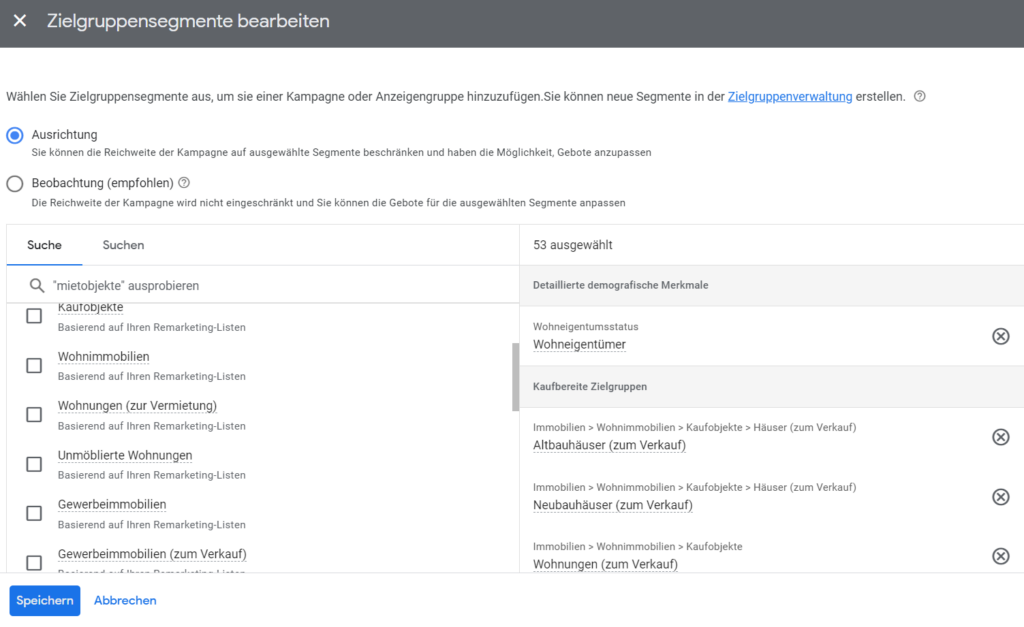
Always a guarantee for extremely high CPMs: Hypertargeting with target group alignments in the Google Ads search network.
High CPM on Google Ads through valuable and highly courted audiences
The high CPM caused by valuable, highly courted target groups usually does not show such extreme increases as with the CPM increase caused by hypertargeting. A heavily courted target group on Google Ads can easily have a CPM of €150 to €500, rarely a CPM of more than €1,000 (as of spring 2023) – but that depends entirely on the industry. It is important here that the CPM through valuable target groups is not technically measured by the purchasing power or the assets of the target group , but by status and interest characteristics that indicate a certain price class purchasing power. The advertisers bid on these specific target group options anddrive up the prices if the target group is particularly valuable . Such status and interest characteristics can be, for example:
- Interested in CRM systems as a business technology (in the B2B sector)
- is a homeowner (in the real estate industry)
- is a CEO of a company with 50-200 employees (that would be LinkedIn Ads targeting with higher CPM as a comparison example to Google Ads).
The higher CPM through valuable target groups is also worthwhile in most cases, since these target groups convert significantly above average with the corresponding high-priced products and services (e.g. B2B services or real estate industry) – i.e. carry out target actions on the website and become leads. As a result, the CPL (cost per lead) can be even cheaper than in “normal” campaigns.
But be careful (!): Such target groups should not be booked into Google Ads in the search network through hypertargeting with a target group orientation, but better with a target group observation and bid adjustment of 30%, for example . If the algorithm has the opportunity to deliver an impression to this target group in the search volume, it will be delivered without overinflating the CPM through hypertargeting that is too rigid.
Here’s an example from the real estate industry : There were a lot of high-quality conversions from the target groups “ homeowners ” and “ old buildings ” that have CPMs of +/- €150 , i.e. well above the average of €24.07 CPM in the account. However, with the “homeowner” status, there was a CPL (cost per lead) of €14.94 , while the average CPL for the entire account was €25.95 . That means: The CPM was significantly higher, but brought more and cheaper leads than the lower CPM.
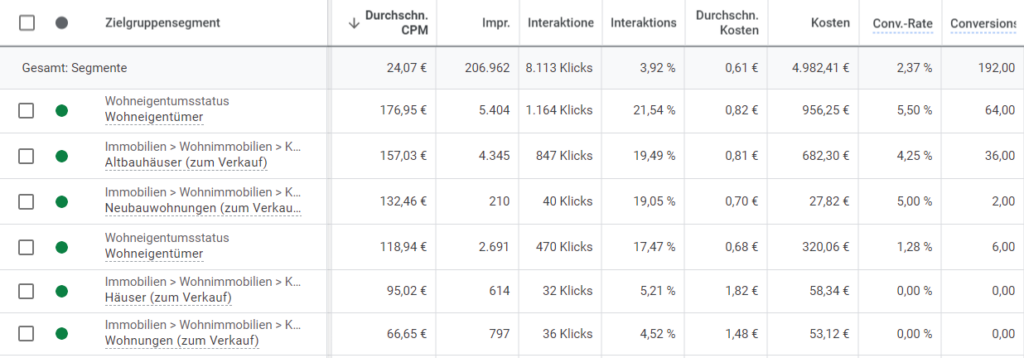
Valuable target groups with high CPMs can really pay off: Homeowners in the real estate industry have a high CPM (here: €176.95 instead of €24.07 in the overall account), but they also have a low cost point per conversion (in this case: contact form submissions) from €14.94.
Conclusion: Is the high CPM worth it for Google Ads?
So in summary, high CPM on Google Ads doesn’t automatically indicate a high-value audience , and the most drastic CPM overshoots come from hypertargeting with multi-nested audience terms and alignments (primarily on CRM and customer lists). It’s not worth it if the lead quality remains the same as in a normal campaign anyway.
On the other hand, what is very often worthwhile with high-priced topics is booking valuable target groups whose CPM is above average – by booking the corresponding (more expensive) keywords in Google Ads, or with an additional suitable target group observation in the campaign and a bid adjustment for The target group. The high CPM of a valuable target group is based on bidding on specific, individual interest and status properties that suggest a certain price class purchasing power or authorization (in the B2B area). The high CPM is createdHowever, not through a generally presumed “wealth” of people in the target group . It’s all about competition for specific target group options, such as interest in buying a corporate CRM or homeownership status for real estate. The more advertisers bid on this, the higher the CPM on Google Ads.
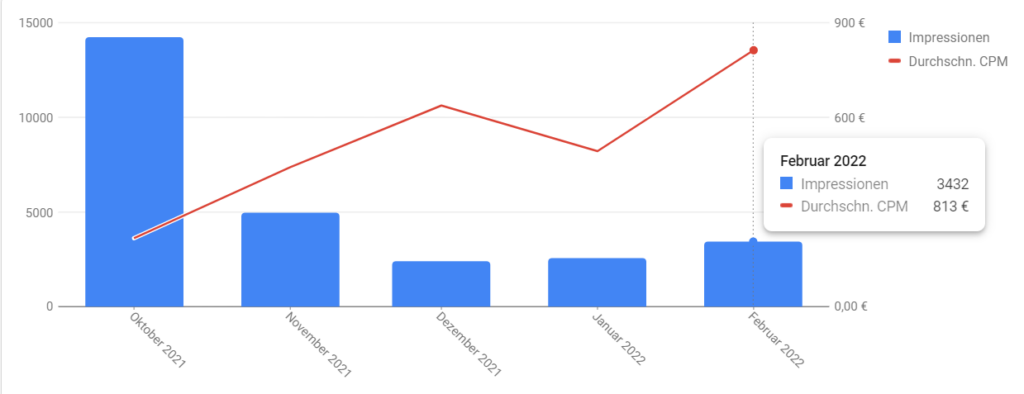
Example of high Google Ads CPM over time.
Have a question about high CPMs on Google Ads?
The use of valuable target groups with high CPM on Google Ads sometimes requires a lot of finesse so that leads and deals can really be generated at a good cost point. If you have any questions about this blog article, feel free to ask:
Ask your question
info@slavawagner.de
Overview
FAQ - Summary of high CPMs on Google Ads
Here is a summary of important and frequently asked questions about high CPMs in Google Ads:
The CPM (cost per 1,000 impressions) in the Google Ads search network is generally measured according to the value of the keyword set you booked and the associated click prices. In addition to ad effectiveness and landing page quality, there are two key cost drivers for a high CPM with Google Ads: Valuable, i.e. competitive target groups in the campaign settings and nested hypertargeting. The more convoluted and complex your targeting, the higher your CPM.
Yes, because the more complex your targeting, the higher the CPM on Google Ads. In particular, for audience targeting on the Google Ads search network, if the audience being targeted for targeting (such as a customer list or CRM contact list with 10,000 entries) then the CPM will increase very sharply for the algorithm to deliver to can reach exactly these users as soon as they research a search term for a keyword you have booked.
On the Google Ads search network, you can book audiences under the “Observation” option so that impressions are served to those audiences when the bid adjustment is correct and a user in those audiences searches for a search term that matches your booked keyword. When many advertisers bid on an audience, the price goes up. As a result, valuable and competitive audiences, such as homeowners, have a high CPM. With high-priced topics, high-priced target groups can have a better conversion rate than in a conventional campaign
You might also be interested in:
Schema markups for FAQ questions: More clicks from organic Google search
To have a chance get into the related questions section at the top of Google Search, you can set up your answered questions with FAQ schema markup.
How to install the AMP integration on WordPress websites according to GDPR
With the AMP integration you can get up to 25% more organic impressions in search engines on your website.

